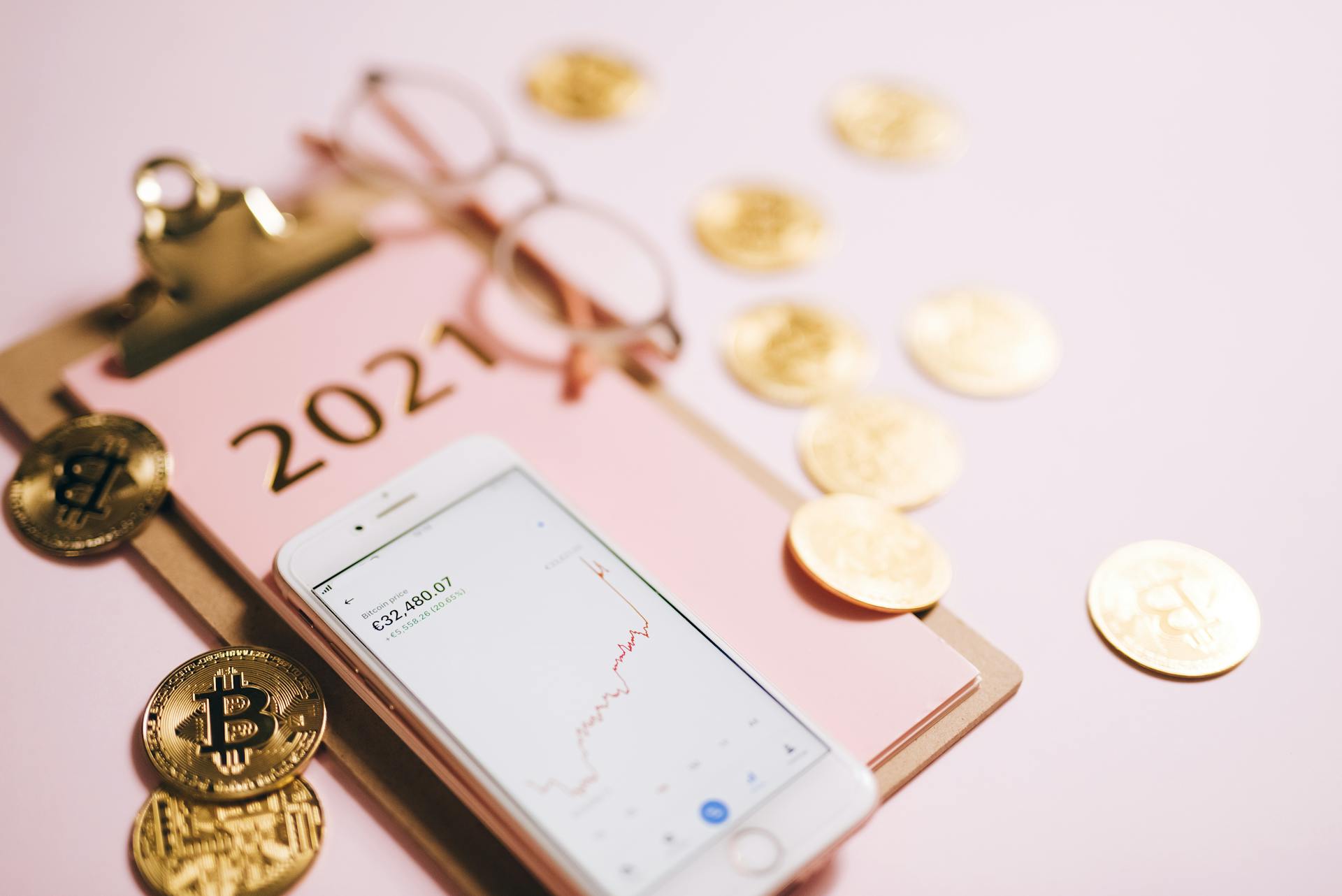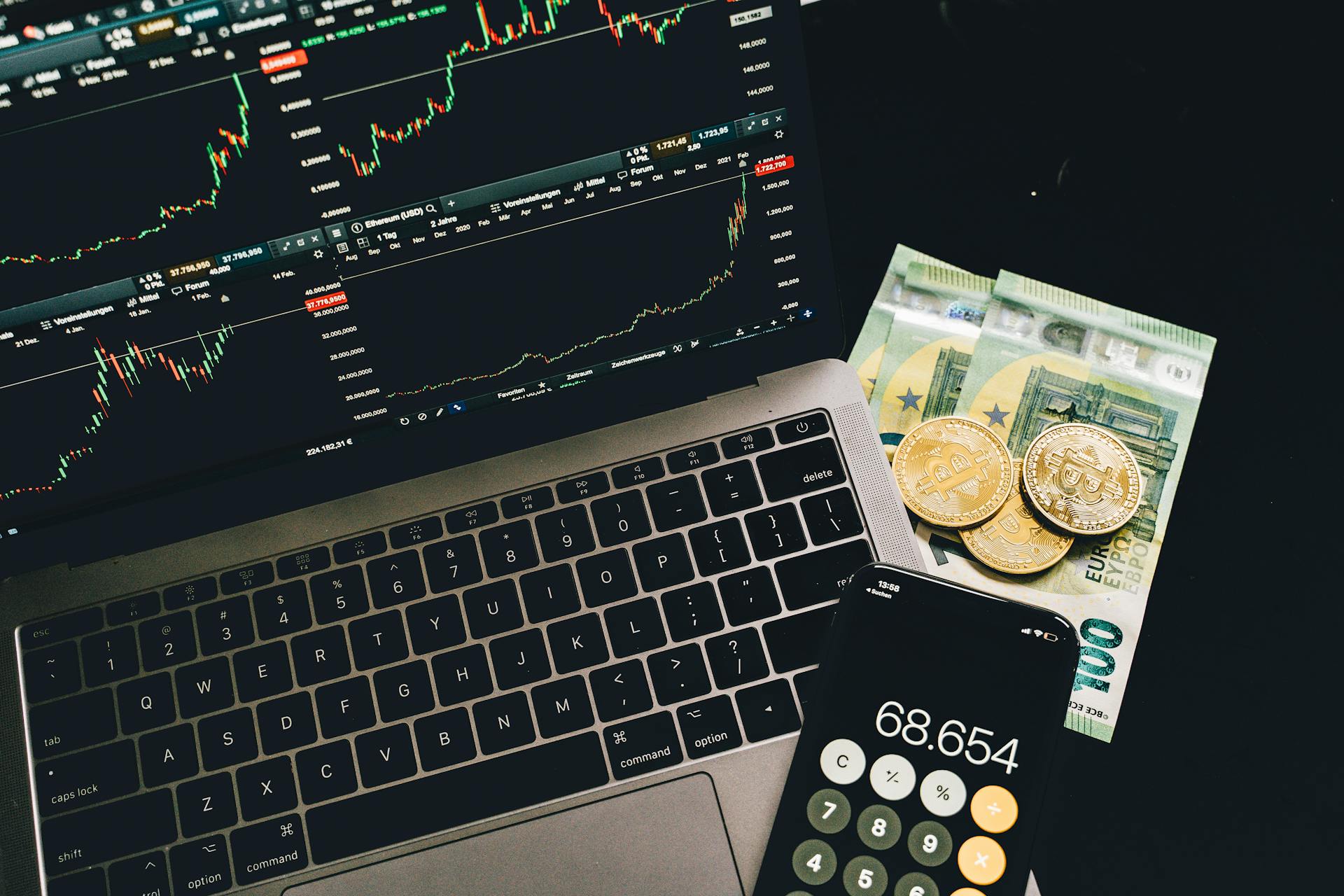
The cryptocurrency market has experienced a significant surge in recent years, with many digital currencies skyrocketing in value. This rapid growth has led to concerns about a potential bubble in the market.
The rapid growth of cryptocurrency prices can be attributed to the massive influx of new investors, who are largely driven by speculation and FOMO (fear of missing out). This has created a self-reinforcing cycle, where prices rise due to increased demand, which in turn attracts even more investors.
The market capitalization of Bitcoin, for example, has grown exponentially, reaching a high of over $1 trillion in 2021. This represents a staggering increase from its initial value of around $0.08 in 2009.
What is a Bubble?
A bubble is a fragile phenomenon that can occur in the cryptocurrency market. It's characterized by prices rising much higher than the actual value of digital assets.
The prices of cryptocurrencies like Bitcoin and Ethereum can become detached from their true worth due to hype and excitement. This can lead to a sharp drop in prices when the bubble bursts.
It often happens because people believe prices will keep going up, creating a self-reinforcing cycle.
What Is Currency?
Currency is a medium of exchange that allows us to trade goods and services. It's something we use every day, often without giving it a second thought.
A cryptocurrency is a type of currency that exists only in digital form, like Bitcoin or Ethereum. It's a relatively new concept that's gained a lot of attention in recent years.
Cryptocurrencies are bought and sold on online exchanges, and their prices can fluctuate rapidly. This can lead to a sharp drop in prices if the market suddenly shifts.
In fact, a cryptocurrency bubble occurs when the prices of digital assets rise much higher than their actual value, often due to hype and excitement.
Hype and Technology
Hype and technology are two key factors behind the formation of a cryptocurrency bubble.
A key factor behind crypto bubbles is the promise of groundbreaking technology. Concepts like blockchain, smart contracts, decentralized finance (DeFi), and non-fungible tokens (NFTs) generate huge excitement. While these innovations have real potential, the hype often leads to inflated expectations.
The DeFi trend became incredibly popular in 2021, with the amount of money locked into decentralized platforms reaching over $100 billion by November of that year. This hype led to a sharp rise in prices, but also set the stage for a dramatic collapse.
The technology adoption lifecycle is another factor that contributes to the formation of a crypto bubble. As a technology moves through this cycle, cryptocurrency prices can respond dramatically.
Here's a breakdown of the technology adoption lifecycle:
As the market matures and moves towards the early majority, prices may stabilize before late majority hesitation contributes to demand reduction and potential depreciation. This is exactly what happened with the DeFi project Terra, which saw its stablecoin UST and its sister token Luna collapse, wiping out over $40 billion in value almost overnight.
What is a Form?
A bubble is essentially a period of time when something, like a cryptocurrency, rapidly increases in value and then just as quickly collapses. This happens when a large group of people become overly enthusiastic about an asset and drive up its price.
Cryptocurrency bubbles don't form overnight; they develop through a series of stages influenced by various factors. These stages can take months or even years to unfold.
The formation of a bubble is often driven by speculation, where people buy an asset in the hopes of selling it later at a higher price. This can create a snowball effect, where more and more people jump into the market, further driving up prices.
As prices rise, it becomes increasingly difficult for rational thinking to prevail, and people become more and more caught up in the excitement of the market. This can lead to a situation where people are buying an asset not because they think it has any real value, but simply because they think it will go up in value.
Causes and Consequences
Market speculation is a significant contributor to the volatility in the cryptocurrency space. It's driven by short-term trading based on expectations of future price movements rather than the intrinsic value of the assets.
Speculators often drive prices without strong fundamentals, leading to rapid price inflations and subsequent crashes. This can be a major concern for investors, as it can result in significant losses.
The crypto market is particularly prone to bubbles due to its unique traits. One of the main reasons is the presence of inexperienced investors who are drawn in by stories of astronomical gains.
These newcomers often jump in without fully understanding the market dynamics, leading to a surge in demand and, consequently, prices. This can create a self-reinforcing cycle, where rising prices attract more buyers, further inflating the bubble.
Fear of missing out (FOMO) is another factor that contributes to crypto bubbles. As prices begin to climb, the fear of missing out on potential gains propels even more people into the market.
This FOMO can create a snowball effect, where rising prices attract more buyers, further inflating the bubble. Media hype also plays a significant role in amplifying crypto bubbles.
Mainstream outlets often report on the soaring prices of cryptocurrencies, sparking widespread interest. This media coverage often lacks critical analysis, focusing instead on the sensational aspects, which drives more people to invest, inflating the bubble further.
The bandwagon effect is another social behavior that influences financial decisions. When people see their peers, influencers, or even institutions buying into crypto, they are more likely to follow suit, believing it to be a smart move.
This collective behavior can push prices to unsustainable heights. Social media and online communities also play a crucial role in the formation of crypto bubbles.
Platforms like Twitter, Reddit, and Discord allow for rapid dissemination of information, often unverified, that can trigger buying frenzies. The influence of these platforms cannot be understated in how they can quickly turn a niche asset into a viral investment, further inflating the bubble.
Speculative trading and leverage are also factors that contribute to crypto bubbles. The availability of high leverage in crypto trading allows investors to bet big on price movements.
While this can amplify profits, it also increases the risk of rapid market corrections. When leveraged positions start to unwind, it can trigger sharp declines, bursting the bubble.
Here's a summary of the causes of crypto bubbles:
- Inexperienced investors
- Fear of missing out (FOMO)
- Media hype
- The bandwagon effect
- Social media and online communities
- Speculative trading and leverage
Understanding these dynamics is key to navigating the volatile world of cryptocurrency.
History of Cryptocurrency Bubbles
The history of cryptocurrency bubbles is a wild ride. Since the inception of Bitcoin in 2009, we've witnessed several boom and bust cycles. Market speculation, technological advancements, and regulatory influences are frequently the driving forces behind these cycles.
The first appearance of the crypto bubble actually dates back to the early days of Bitcoin, when its price skyrocketed from a few cents to over $30 in a matter of months in 2011. This spike in value caught the attention of both investors and the media, leading to a frenzy of buying and speculation.
The infamous Bitcoin bubble of 2017 is the one that taught many investors the term crypto bubble; the price soared to almost $20,000 and then crashed to around $3,000 just a year later. This unprecedented price volatility shocked the financial world and left many investors confused about the future stability and adaptability of cryptocurrencies.
Bitcoin has witnessed several bubbles since its inception in 2009, with one of the most notable occurring in 2017 when Bitcoin's price skyrocketed to nearly $20,000, only to plummet to around $3,000 a year later. Despite these dramatic fluctuations, Bitcoin has demonstrated remarkable resilience, rebounding and reaching new heights in subsequent years.
The year 2017 witnessed an unprecedented boom in the cryptocurrency market, with Bitcoin reaching nearly $20,000. This surge was fueled by the proliferation of Initial Coin Offerings (ICOs) and heightened mainstream media coverage.
Between 2017 and 2018, the cryptocurrency space witnessed the ICO boom, where numerous new tokens were sold to investors in a bid to raise capital for blockchain-related projects. This period was characterized by a frenzy of investment and speculation, with ICOs raising billions of dollars, only for many to fail to deliver on their promises, leading to massive losses for investors.
The most recent example of a crypto bubble was in 2021, when the price of Bitcoin reached an all-time high of over $60,000 before experiencing a significant correction. These bubbles and corrections serve as important reminders that the crypto market is still in its early stages of development and lacks the stability of traditional financial markets.
Warning Signs and Indicators
A bubble in cryptocurrency can be identified by several warning signs and indicators. High volatility is a key sign, as extreme and frequent price swings often signal a bubble. This is because price changes are driven by speculation rather than solid market fundamentals.
Sharp increases in trading volumes can also indicate a bubble. A sudden rise in trading activity can suggest that the market is driven by emotion and short-term gains rather than long-term value.
Over-leveraging is another warning sign. Using borrowed money to trade cryptocurrencies can amplify gains but also increase risks. When leverage is widely used in the market, it can create instability and lead to sharp declines if prices fall suddenly.
A flood of new projects is another indicator of a bubble. During a bubble, many new cryptocurrencies, tokens, or projects appear, often promising high returns but offering little actual value.
Intense media and social media hype can also be a warning sign. When cryptocurrencies dominate news headlines and social media feeds, it often creates a rush of new investors who may not fully understand the market.
Disconnect from fundamentals is another indicator. When the price of a cryptocurrency grows much faster than its actual usage or technological progress, it's a sign that the market is driven largely by speculation.
A Fear and Greed Index reading of extreme greed can also signal a bubble. This index measures market sentiment, ranging from extreme fear (low prices) to extreme greed (high prices).
Here are some specific indicators to watch for:
These warning signs and indicators can help investors navigate the volatile crypto markets and avoid getting caught up in speculative bubbles.
Preparing for a Bubble Burst
A potential burst in the crypto market might be preceded by a sudden dip in trading volumes, negative news triggering panic, or a shift in investor sentiment. Technological vulnerabilities or regulatory crackdowns can also signal a possible market downturn.
The most notable historical precedent for crypto market bubbles bursting is the collapse of the Bitcoin bubble in December 2017, where its price significantly fell after an extraordinary bull run.
To prepare for a bubble burst, it's essential to have a well-planned exit strategy in place to protect your investments.
Having a plan in place can help alleviate stress and uncertainty during turbulent market conditions. Be mentally prepared for the possibility of a market crash and its potential impact on your investments.
If the crypto bubble bursts, it's crucial to stay composed and approach the situation with a clear mind.
Assess and rebalance your portfolio after a market crash, determining whether you need to make adjustments to reduce risk or to capitalize on new opportunities.
Every market downturn provides valuable lessons, so reflect on what happened, what led to the bubble, and what you could have done differently.
Post-crash environments can present unique opportunities to buy strong cryptocurrencies at significantly reduced prices, but it's essential to conduct thorough research before making any moves.
Notable Collapses and Lessons
The cryptocurrency market has seen its fair share of bubbles, and some have been more notable than others. The first major bubble occurred in 2011, when Bitcoin's price skyrocketed from a few cents to over $30 in a matter of months.
One of the most infamous bubbles was the Bitcoin bubble of 2017, where the price soared to almost $20,000 and then crashed to around $3,000 just a year later. This unprecedented price volatility shocked the financial world and left many investors confused.
The collapse of the Bitcoin bubble in December 2017 serves as a notable historical precedent for crypto market bubbles bursting. Despite the dramatic fluctuations, Bitcoin has demonstrated remarkable resilience, rebounding and reaching new heights in subsequent years.
In 2021, the price of Bitcoin reached an all-time high of over $60,000 before experiencing a significant correction. This pattern of rapid growth followed by sharp declines is a hallmark of Bitcoin's history, reflecting both the volatility and the potential of the cryptocurrency market.
The type of bubble that cryptocurrencies could be is a concern, but it's worth noting that digital currencies tend to be isolated from the broader financial system, potentially providing a buffer against interventions. This isolation could limit the potential damage of a cryptocurrency bubble's collapsing.
How to Handle
Handling a crypto bubble requires a solid strategy to mitigate risks and protect your investments. Diversification is key, so consider spreading your investments across multiple digital assets using crypto baskets.
Regularly tracking market trends is crucial to identify and respond to a crypto bubble. Tools like the Fear and Greed Index can help gauge market sentiment and potential market shifts.
Having a well-defined investment strategy is essential, especially during volatile periods. Stick to your plan and avoid making impulsive decisions based on sudden price movements or external noise.
Taking profits off the table can be a wise decision if you've experienced substantial gains during a rapid price increase. This doesn't mean selling all your holdings, but strategically securing some of your earnings can protect you from potential losses.
Crypto markets are inherently volatile, and bubbles amplify this volatility. Be mentally and financially prepared for significant price swings and understand that corrections are a natural part of market cycles.
Frequently Asked Questions
What is a bubble coin?
Bubble (BUB) is a cryptocurrency with a limited supply of 768,753 units, currently trading on one active market. Learn more about its price, market activity, and potential uses.
Sources
- https://b2binpay.com/en/news/are-we-in-a-crypto-bubble-unpacking-market-hype-history-and-the-future-of-cryptocurrency
- https://coinpaper.com/3559/crypto-bubble-burst-the-aftermath-and-future-implications
- https://www.morpher.com/blog/the-crypto-bubble
- https://www.investopedia.com/news/cryptocurrency-bubble-more-housing-or-dotcom/
- https://plisio.net/blog/crypto-bubble
Featured Images: pexels.com


